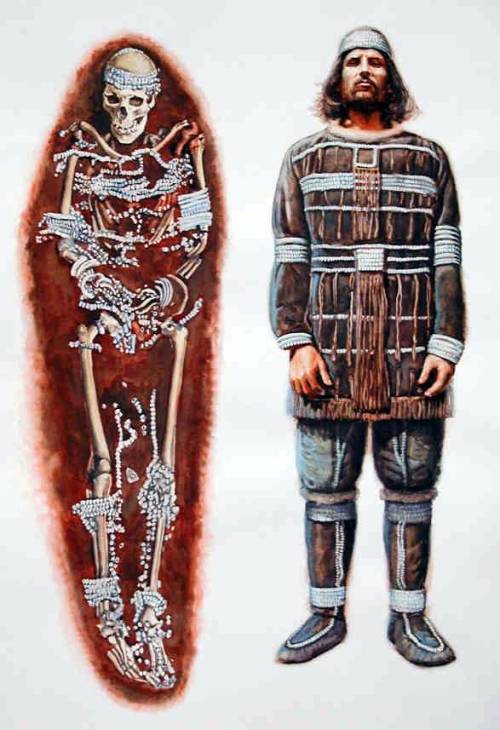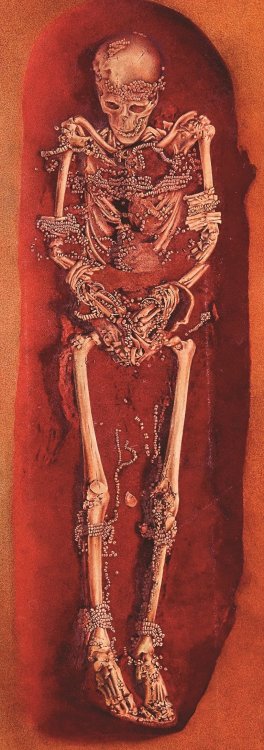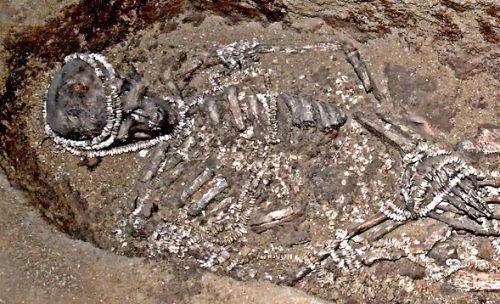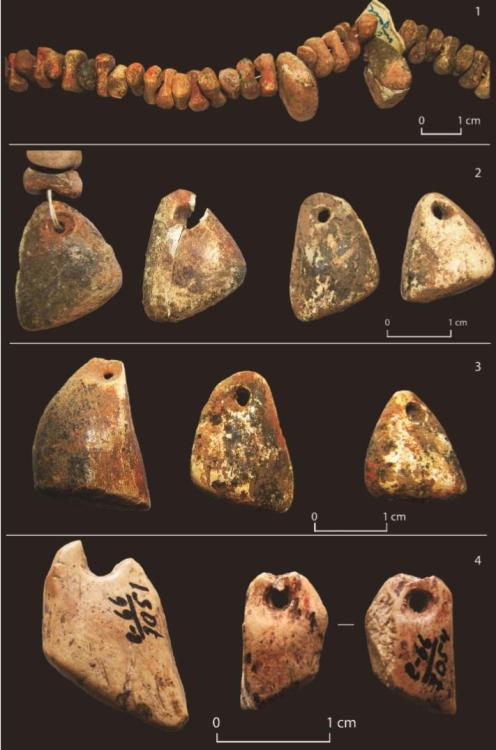#homo sapiens
Sungir
Sungir is the name of an archeological site in Russia, slightly north east of Moscow, that was discovered in 1955. The discovery was an accident as local digging from clay pits eventually led to the discovery of an ancient human settlement and burial site. The site has been dated back to somewhere around 33,000BC and is therefore a real treasure trove for researchers researching the lifestyle of early European homo sapiens.
What makes the Sungir site especially fascinating is the discovery of extremely extravagant burials. One example is a buried male, who died somewhere between the age of 35-45. It is not certain how he died but he probably died quite suddenly from an injury in his neck. He was buried with elaborate decorations including 3,000 beads made of mammoth ivory, fox teeth and ivory bracelets. It took early humans about 40 minutes to make just one ivory bead so imagine how much time they spent making 3,000 of them.
Two other richly decorated graves were found, which belonged to two adolescent children. These two were placed together in a grave with an adult femur bone. Both children were also decorated with thousands of mammoth ivory beads, red ochre, bracelets, fox teeth (they would have needed to slay at least 20 foxes for this burial), mammoth ivory spears, disks and pierced antlers.
This site is extremely important because it gives us clues into the spiritual lives of our earliest European ancestors. There has to be of course a reason why these three individuals were buried with such riches. If you count the man-hours of all the found decorations, it would be at least 10,000 hours. Why were these people buried with all of these items?
Several theories about the reason why they were buried like this exists, sadly it is impossible to be absolutely sure about a theory since these ancient people haven’t written anything down. One theory suggests that these individuals were part of an ancient ritualistic sacrifice. Perhaps they were sacrificed to the landspirits for certain blessings, it would explain the extreme amount of jewelry and unique burial style.
Another theory suggests that these three individuals were of a high status, perhaps the adult male was the chief of the tribe and suffered from a hunting injury that ultimately cost him his life, his high status could be the reason why he received so many burial gifts but it doesn’t explain why the two children were also buried with such rich gifts.
It wasn’t until 2017 when scientists finally fully sequenced the DNA of the two children, the adult male and the adult femur bone. All four individuals are male but none of them are direct family members of each other so the children were not the high status offspring of the buried adult male. This would mean that the theory of a possible human sacrifice seems more likely than the theory of high status burials.
One important detail that I want to add is the fact that both the children and the adult male show physical abnormalities in their remains. This might perhaps be the reason why they were part of a ritual, if the ritual theory is correct, and why they were given such an odd burial. Perhaps they were viewed as gifted people thanks to their disabilities. One of the children, a 10 year old boy, has femurs which are unusually short and the other boy, 12 years old, shows an abnormality in his upper jaw.
There is still so much to learn about ancient paleolithic spiritual practices. It is also unfortunately an incredibly hard subject since there is so little evidence and we have to make conclusions based on the lifestyle of modern day hunters and gatherers which is of course not 100% reliable. But piece by piece and through careful research we might perhaps reconstruct bits of ancient spiritual practices of our earliest European ancestors.
Here are images of:
Sungir grave of the adult male,
Sungir grave of the two children,
Bones of the children showing abnormalities<
Bone jewelry found at Sungir
Post link
Cro Magnon
The Cro Magnon humans were the earliest modern humans to settle in Europe. They are thus not a seperate extinct species of human but they are our earliest European ancestors. It is however not fully certain when modern humans, homo sapiens, entered Europe. Some historians agree on a date somewhere around 50,000BC while others suggest that the Cro Magnon entered Europe 210,000 years ago. This theory is based on skull fragments found in Greece.
Even though the Cro Magnon were modern humans, they did not look exactly the same as present day humans. The evolutionary path of our species is always moving, adapting to our current living situations. Our species and the Neanderthals have a common ancestor whose features were quite visible in the Cro Magnon human. The brow ridges were more prominent, the teeth were larger, they did not yet have the slight overbite of our upper jaw which enables us to make the ‘W’ sound. They were build much more robust compared to present day modern humans, it is clear that they were well adapted to the cold.
It was the Cro Magnon who encountered the then still present Neanderthals in Europe. We do not fully understand why the Neanderthals disappeared while we continued to evolve and develop our technologies. It is unlikely that a long lasting conflict between the two species is the cause of the Neanderthal’s demise. A possible theory is that modern humans are much more fertile. Their population was much bigger than that of the Neanderthals and they eventually started to have children with the Neanderthals as well.
If real love existed between both species is unknown but it is an interesting concept to think about. It is possible that through these factors, the Neanderthals were slowly pushed out of existence, since Neanderthal women weren’t as fertile as modern day female humans are, it is likely that Neanderthals started having relationships with modern day humans until eventually the last pure Neanderthal disappeared. They are not completely gone from this world, we all carry parts of Neanderthal genes inside of us.
The Cro Magnon are also the earliest humans with a distinct taste for art, the most famous example is perhaps the 'Venus’ statue. These statues have been found throughout Europe but we still do not know for which purpose they were created, a topic for a post in the future. They wore jewelry, most likely piercings and tattoos and other body art like painting the body with a dye.
These early humans also made music by using instruments such as bone flutes and whistles. Unfortunately wood and skin decays pretty rapidly so we do not know if they used other prehistoric instruments such as drums and bullroarers but if we compare the Cro Magnon with still existing tribes, it is very likely that they did play on such instruments.
Eventually the Cro Magnon developed distinct cultures throughout Europe and these in turn developed into the mesolithic cultures. Their bodies slowly evolved into the bodies that we have today, although evolution is an ever continuing process so who knows how the homo sapiens species will look like in another 100,000 years. When will we have changed so much that we can call it an another human species?
Here are images of:
Reconstruction of a Cro Magnon male (Lascaux III) by Élisabeth Daynès.
A skull of a Cro Magnon.
Venus statue found in Kostenki, Russia.
Post link
Maybe you weren’t a terrible person maybe you were just fifteen
‘Mothers’
The story of a meeting of two single mothers, during the Ice Age, when our problems and a daily struggle for survival were not so different from the wolf ones :) Who knows, maybe this meeting has just led to mutual cooperation, understanding and initiated a species bond that survived to today.
As you know in my work, wild nature, especially wolves, has always been very important and was an infinite source of inspiration for me. I decided to finally thank them for these years of inspiration. For some time, together with my wife, we are supporting The Association for Nature “Wolf”. People who work there, headed by dr hab. Sabina Nowak, are one of the best specialists in this field in the world, full of passion, knowledge and positive energy, I admire them very much!
All profit from the sale of this painting will be transferred to the account of The Association for Nature “Wolf”. So, if you like this painting and want to support Polish/Europen wolves, I will be very grateful!
Prints:https://society6.com/mrwerewolf
Work process: https://www.artstation.com/artwork/ybwoeO
Post link















